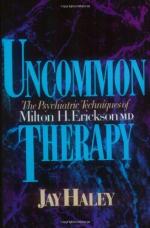
|
| Name: _________________________ | Period: ___________________ |
This test consists of 15 multiple choice questions and 5 short answer questions.
Multiple Choice Questions
1. Erickson's therapy includes and involves helping the _____ patients to overcome their fears surrounding dating issues.
(a) Adult.
(b) Child.
(c) Adolescent.
(d) Homosexual.
2. In Chapter 5, Haley shows how Erickson applied therapy when the challenge was to help new parents over into the ______ of being parents.
(a) Regression.
(b) Involvement.
(c) Phase of life.
(d) Evolution.
3. Addressing their fears and insecurities while helping them to make some needed _______ are all part of the therapy for those who want this.
(a) Transformations.
(b) Regressions.
(c) Evolutions.
(d) Admissions.
4. The one condition on which Erickson allows couples to fight was that they genuinely seek to what?
(a) Not shout.
(b) Resolve the disagreement in a conclusive and definitive manner.
(c) Not speak to the therapist as a third party.
(d) Not involve their children in their disputes.
5. In what technique does Erickson use trance to release people from deep-seated behavior patterns, some of which have been counter productive or relied upon to reduce fears?
(a) "Revision of nature".
(b) "Encouraging a relapse".
(c) "Communicating in metaphor".
(d) "Frustrating the problem".
6. Harold's experience with his first relationship was so good that he voluntarily reconsidered his own views and chose to do what?
(a) Have a sex change.
(b) Pursue women.
(c) Pursue men.
(d) Have children.
7. Harold became negative about the _______ with whom he had had been sexually involved in a limited sense.
(a) Older women.
(b) Younger men.
(c) Young women.
(d) Ex-girlfriends.
8. When Harold has succeeded in school, Erickson persuades him to drop the idea that he is somehow _____ minded.
(a) Strong.
(b) Powerfully.
(c) Feeble.
(d) Intelligently.
9. One of the most prominent facts about Chapter 5 is that what early in a marriage are a common and readily treatable problem?
(a) Compatibility issues.
(b) Sexual difficulties.
(c) Dominance difficulties.
(d) Financial worries.
10. In Chapter 5, Erickson and Haley both admit that not all young adults want to do what?
(a) Take medication.
(b) Marry.
(c) Help themselves.
(d) Seek therapy.
11. Haley writes of one case in which a woman was directly threatened with death by her husband over what?
(a) Her family.
(b) Her infidelity.
(c) Her spending.
(d) The gender of their baby.
12. Haley points out that Erickson had suffered from _____ twice and had been debilitated by it/them.
(a) Heart attacks.
(b) Strokes.
(c) Polio.
(d) Nervous breakdowns.
13. In Chapter 5, Haley writes about a case in which a wealthy woman had to be tranced into more full awareness of her feelings of acceptance during her childhood and how this set a healthy foundation for her to feel confident in her ability to do what?
(a) Speak to her husband about insecurity.
(b) Have sexual intercourse.
(c) Be a good wife.
(d) Be a good mother.
14. The presence of a child or children creates a variant of the _____, which only grows in complexity with the advent of additional children.
(a) "Building blocks".
(b) "Family circle".
(c) "Love triangle".
(d) "Bridge of Connection".
15. Haley states in Chapter 2 that a pattern involving a built-in need for making changes and adjustments is part of what?
(a) The phase of bearing children.
(b) The phase of adolescence.
(c) The phase of marriage.
(d) The phase of old age.
Short Answer Questions
1. Erickson addresses Harold's anxieties and hatred about women in a simple way. He ______ a relationship with a woman who teaches him.
2. The amnesia seems to be for the purpose of helping the clients themselves to be able to feel as if he has not done what?
3. Erickson was able to encourage an "Asthmatic Mama's boy" out of the role of sickly and meek and out into the realm of what?
4. Haley explains that there are times when _____ rather than the family of origin are the real source of the problem.
5. Harold would finally happen into a heterosexual relationship with whom?
|
This section contains 627 words (approx. 3 pages at 300 words per page) |

|




